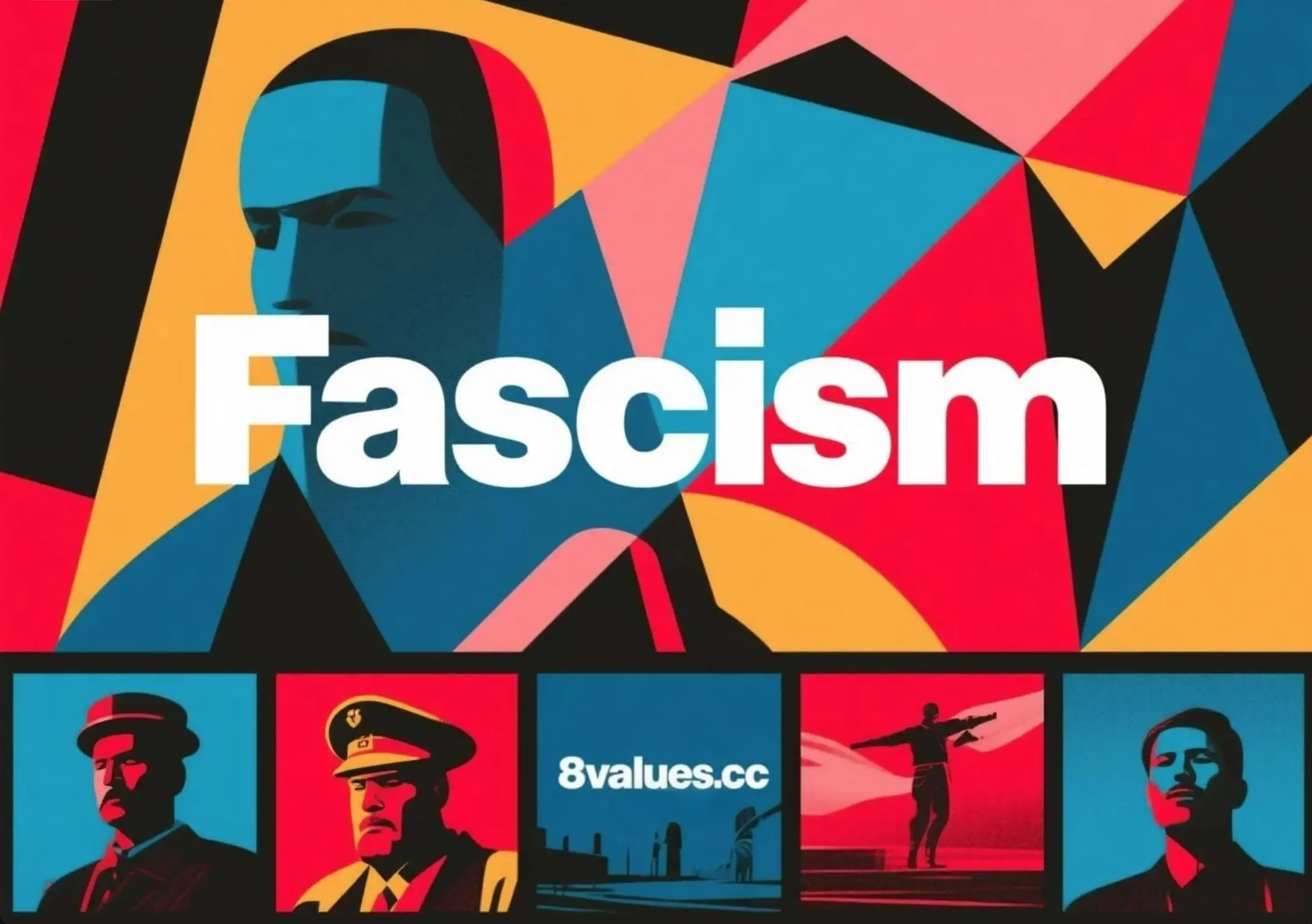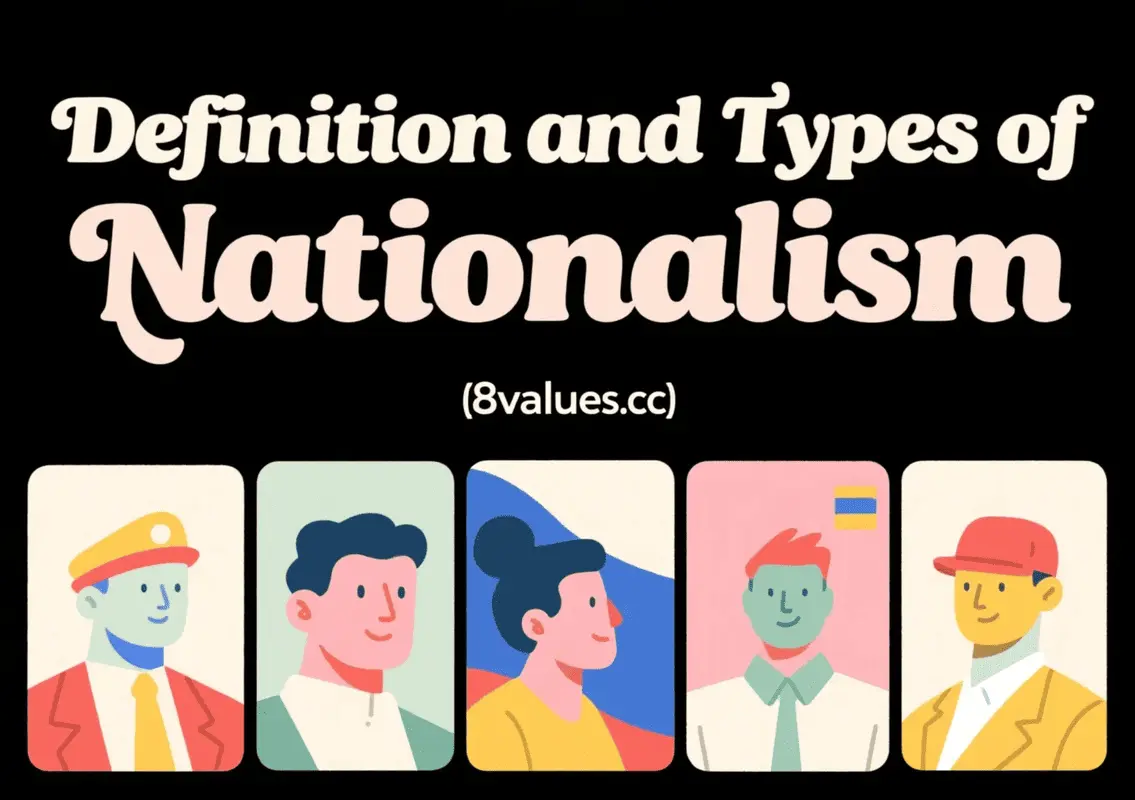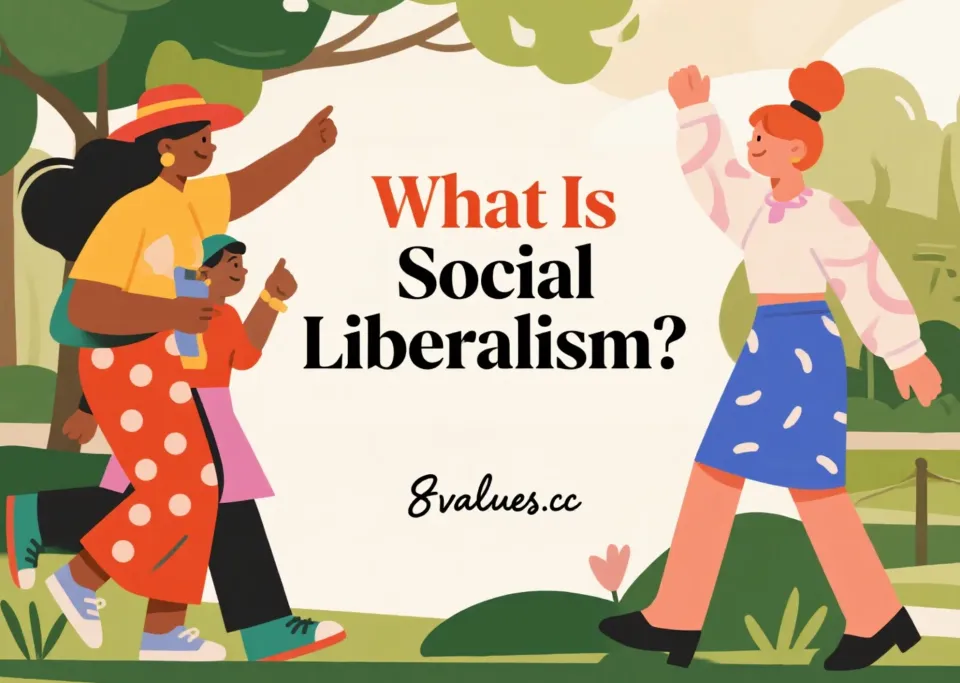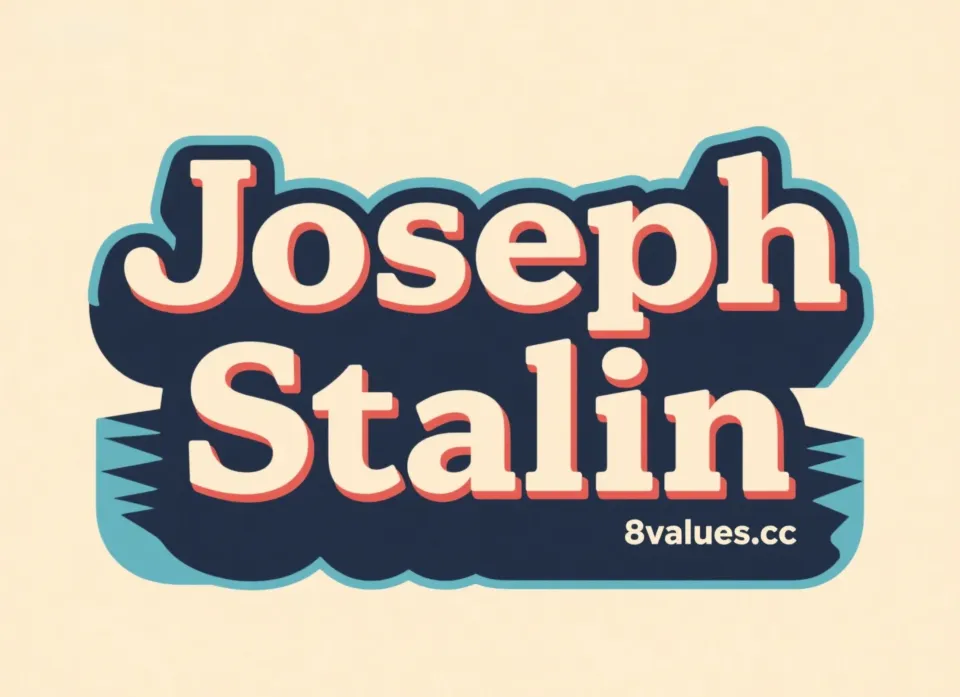Fascismo | 8 Valoras Interpretación de la ideología ideológica en las pruebas políticas
Explore la ideología 'fascista' en la prueba de 8 valores de tendencia política. Este artículo analizará profundamente el origen, las características centrales, los modelos económicos, las similitudes y las diferencias con el nazismo, así como su evolución y amenazas en la historia y los tiempos contemporáneos. Comprender este complejo fenómeno político lo ayudará a comprender el espectro político de manera más integral y consciente de sí mismo a través de la prueba política de 8 valores.
El fascismo, como una poderosa ola política en Europa a principios del siglo XX, todavía tiene un profundo impacto en el pensamiento político global y los procesos históricos. Entre los 52 resultados ideológicos de la prueba política de los 8 valores, el "fascismo" representa una postura política única y una visión del mundo. No es un simple sinónimo de "malo", sino una filosofía política compleja y contradictoria, cuya historia de ascenso y caída proporciona lecciones profundas para la sociedad humana. Este artículo combinará las opiniones de muchos historiadores y materiales originales para interpretar de manera integral todos los aspectos del fascismo para ayudarlo a tener una comprensión más clara de usted y otras tendencias políticas después de completar el análisis coordinado del espectro político de 8 valores .
La etimología y el concepto central del fascismo
La palabra "fascismo" proviene de la palabra latina "fasces", que significa "estiramiento de palos" o "privilegios". En la antigua Roma, cuando el cónsul realizó una gira, se insertó un hacha afilada en el medio del palo transportado por los guardias. Este palo era un símbolo del mayor poder del país romano, que significa "unidad, unidad, unidad de todo el pueblo" y "violencia, autoridad". Esta caña fue una vez un instrumento de tortura, que el cónsul podría sentenciar al criminal hasta la muerte. Cuando Mussolini fundó el Partido Fascista Nacional Italiano, eligió el "fascismo" como su nombre y logotipo de su partido, y siguió las costumbres y etiqueta de la antigua Roma, como el uso de camisas negras como uniformes, patrones de palos como emblemas de la fiesta y reemplazar la ceremonia tradicional de la cadena de mano con salutos romanos con los salutos romanos, para "restaurar los logros gloriosos de la antigua roma" ".
El núcleo del fascismo se encuentra en su posición como un estado o nación por encima del individuo, enfatizando que "los individuos obedecen al colectivo, los colectivos obedecen a los líderes". La filosofía fascista de Mussolini cree que el estado es absoluto, y los grupos o individuos individuales son inimaginables fuera del estado. Solo a través del estado se puede realizar la verdadera racionalidad y el libre albedrío de las personas, por lo que las personas deben obedecer absolutamente al estado. Es un "modelo de política totalitaria" que moviliza completamente a la sociedad a través de un líder poderoso, a saber, el dictador y el partido fascista gobernante para establecer una unidad nacional y mantener una sociedad estable y ordenada.
Roger Griffin señaló que el núcleo del mito del fascismo es que la crisis nacional anuncia el nacimiento de una nueva orden , es decir, la sociedad nacional se renunciará después de ser purificado y revivido. Este nacionalismo extremo de la palingenesis es una característica definitoria del fascismo. Defiende las acciones políticas en la búsqueda de una sociedad perfecta y se considera un "evangelio político" que puede satisfacer las necesidades psicológicas de la sociedad en su conjunto. El fascismo se clasifica como una fuerza reaccionaria "de extrema derecha" sobre el espectro político, caracterizado por el nacionalismo agresivo y la filosofía política totalitaria anticomunista y antibliberal.
Antecedentes sociales y el surgimiento del fascismo después de la Primera Guerra Mundial
El surgimiento del fascismo no es accidental. Es el producto de una serie de crisis políticas, económicas y sociales entrelazadas por países europeos después de la Primera Guerra Mundial, especialmente Italia y Alemania. El camino a Europa está lleno de una sensación de declive, y las personas están llenas de ansiedad y miedo al futuro.
"Victoria incompleta" y caos en Italia después de la guerra
Durante la Primera Guerra Mundial, Italia pagó un gran precio y sufrió grandes bajas. Sin embargo, en la conferencia de paz de la posguerra de París, Italia no ganó mucho beneficio como un país victorioso, e incluso no tenía voz en los "Tres grandes" e fue considerado un "Loseman of the Peace Conference". El historiador italiano Crozzi cree que la guerra no solo trajo un trauma fatal a Italia, sino que también dejó úlceras visibles. Esto hace que Italia sienta una sensación de "depresión" y humillación.
Económicamente, Italia sufrió un gran golpe después de la guerra, el valor de la moneda de lira al oro cayó bruscamente, la moneda estaba brutalmente inflada, la relación de los bonos del gobierno al PIB era extremadamente alto y el país estaba muy endeudado. Como resultado, la sociedad se volvió caótica, los precios se dispararon y la vida de las personas se encontraba en una situación difícil. En 1920, estallaron más de 2,000 ataques en Italia, con más de 2.3 millones de personas participando, una gran escala. Estos huelgas incluso se convirtieron en amenazas armadas y ocupación de fábricas, conocidas como los "dos años rojos". Detrás de esto está el Partido Comunista que incita y aboga, que ha provocado el miedo a la Revolución Comunista. Los gigantes industriales y comerciales y los grandes propietarios sienten una gran amenaza para el surgimiento de la izquierda.
Mussolini y el partido fascista llegan al poder
En tales disturbios sociales, Benito Mussolini y su partido fascista surgieron. Mussolini fue considerado "maestro de Hitler" e inspiró a Hitler. Utilizó el aburrimiento de la sociedad con el caos, las huelgas y la amenaza del comunismo, así como la frustración de la clase media, para presentar la afirmación de que "la acción es mejor que las promesas". El Partido Fascista inicialmente estaba compuesto por un grupo de veteranos con un fuerte sentimiento nacionalista que se sintió descuidado por la sociedad y entregados por los políticos.
En las elecciones parlamentarias italianas de 1921, el Partido Fascista ganó 105 escaños de 535 escaños. Sin embargo, Mussolini no estaba satisfecho. En 1922, pidió a más de 30,000 masas fascistas que "marchen en Roma" y tomen el poder a través de un golpe de estado. El rey Victor de Italia, Emmanuel III, finalmente nombró a Mussolini como primer ministro por temor a la guerra civil. Desde entonces, el Partido Fascista ha aumentado rápidamente su escaño en el Congreso y ha controlado casi por completo al Congreso en 1929 y 1934. Vale la pena señalar que el pánico económico aún no había ocurrido cuando el Partido Fascista llegó al poder (1922), lo que indica que el caos de posguerra en sí mismo brindó una oportunidad para el fascismo.
Situaciones similares en Alemania
Alemania también experimentó un fondo social similar después de la guerra. Alemania estaba al borde del colapso debido al fracaso de la Primera Guerra Mundial, la pérdida de territorio, enormes reparaciones y desastres económicos. Se cuestionó la política democrática de la República de Weimar, y la gente generalmente estaba insatisfecha con la incompetencia de la clase dominante y perdió la gloria y el liderazgo autoritario del imperio en el pasado. El éxito de la revolución bolchevique rusa también hizo que los gigantes y propietarios industriales y comerciales alemanes sintieran una gran amenaza para el surgimiento de la izquierda. Esta situación social genera un "espíritu xenófobo" provocativo, agresivo y emocional ".
Las características distintivas del fascismo: trascender los modelos políticos tradicionales
El fascismo no tiene reglas, es "un collage de diferentes ideas filosóficas y políticas, una colmena compuesta de cosas contradictorias". Pero es firmemente emocionalmente firme en algunos prototipos y tiene las siguientes características distintivas:
El nacionalismo extremo y el principio de la supremacía estatal
La característica más fundamental del fascismo es el nacionalismo final , que trasciende el nacionalismo tradicional y enfatiza que una nación es un organismo vivo que trasciende al individuo, tiene vida y destino, puede prosperar, morir o resurrección. Aboga por el concepto de nacionalidad de "orgánico", "raza" o "integrado" y enfatiza la identificación con cultura homogénea, historia compartida y sentido de pertenencia nacional. Este sentido de pertenencia es destruido por factores como el individualismo, el consumismo, la inmigración masiva, el globalismo (cosmopolitismo) y la globalización.
El fascismo elogia la "supremacía del estado", creyendo que el estado siempre es mayor que el individuo, y que el valor personal se reconoce solo cuando es consistente con los intereses nacionales. Para la gloria del país, la agresión y la expansión también se consideran justificadas. Aboga por restaurar la grandeza de la nación. Por ejemplo, el fascismo italiano usa el eslogan de "restaurar la gloria de la antigua Roma" para inspirar el "espíritu patriótico" y el "sentimiento del creyente" de la gente.
Autoritarismo y adoración de liderazgo
El fascismo abandona por completo la política democrática y la reemplaza con la dictadura y los regímenes totalitarios . No cree en la regla mayoritaria a través de consultas regulares, enfatiza la "desigualdad injusta, fructífera y beneficiosa del hombre" y cree que lo ruidoso, la corrupción y la corrupción en la política democrática no son satisfactorios. Desde el punto de vista del fascismo, las personas se construyen como entidades que expresan voluntad común, mientras que los líderes fingen ser sus traductores.
El líder fue deificado y clasificado en el punto más alto de la estructura organizacional en forma de pirámide. Fue el representante de la voluntad de toda la gente y el comandante en jefe de todas las acciones. Por ejemplo, Mussolini se esfuerza por crear su imagen como un "tipo duro" y enfatiza su fortaleza y masculinidad. Su mascota es un león y se afeitó deliberadamente la cabeza para resaltar su masculinidad. Los libros de texto enseñan a los niños a adorar a Mussolini desde una edad temprana y promover sus esfuerzos para el bienestar de la patria y la gente. Este tipo de adoración de líderes es un medio importante de fascismo para mantener la gobernanza sistemática, acompañada de heroísmo y adoración de la muerte.
Abogar por la violencia y el espíritu bélico
El fascismo aboga por la violencia y cree que "actuar para la acción". Frente al caos y huelgas sociales, el Partido Fascista utilizará medios violentos para suprimir a los manifestantes y obligarlos a volver al trabajo. La violencia se considera una herramienta para la "purificación nacional", y la guerra tiene un valor sagrado, y es un medio para que la nación logre "rejuvenecimiento". El fascismo cree que la vida es una guerra permanente, y el pacifismo es una transacción ilegal con el enemigo. Mussolini y Hitler creían firmemente que "una nación cobarde no es digna de supervivencia y deben luchar para consolidar su dominio en el mundo".
Antiliberalismo y anticomunismo
El fascismo es una fuerza reaccionaria anti-liberal, anticomunista y anticonservadora .
- Anti-liberalismo : el fascismo niega completamente los conceptos abstractos del individualismo, la democracia parlamentaria, la economía de libre competencia y la libertad de pensamiento desde el siglo XVIII. Cree que el liberalismo conduce al caos social, la corrupción y el egoísmo personal. Mussolini creía que la democracia era un sistema fallido, y la libertad de expresar opiniones y partidos de forma era hipócrita.
- Anticomunismo : el fascismo y el comunismo son enemigos mortales, tanto el extremo izquierdo como la extrema derecha. Es hostil a la lucha de clases y la dictadura proletaria, y aboga por reemplazar la división de clases con gran unidad nacional. El Partido Fascista suprimió violentamente las huelgas y las organizaciones de trabajadores en respuesta al pánico causado por la revolución bolchevique rusa en Europa.
- Anti-conservador : el fascismo, aunque atribuye importancia a la tradición, rechaza la restauración de la política conservadora no liberal del antiguo orden, pero en su lugar se da cuenta de la regeneración del estado a través del nuevo orden, que refleja su naturaleza revolucionaria y de visión de futuro.
Fascismo y nazismo: disimilitud y comprensión de las similitudes y similitudes
El fascismo y el nazismo a menudo están confundidos, pero los dos no son exactamente lo mismo en concepto. Aunque los dos tienen similitudes en muchos aspectos, como ambos defensores del chovinismo, totalitarismo, dictadura de un solo partido, adoración de líderes y agresión y expansión extranjera. Sin embargo, también hay diferencias significativas entre ellos.
Diferencias centrales: el grado y la función del racismo
En el corazón del nazismo hay racismo extremo y antisemitismo, especialmente la teoría aria de la superioridad y el propósito de eliminar a los judíos. Hitler creía que la historia mundial es la historia de la lucha racial, la nación alemana es la mejor raza del mundo, y la nación judía es la raza "inferior", que debe eliminarse y una política de genocidio a gran escala (Holocausto). La teoría nazi "Lebensraum" también estaba directamente relacionada con la expansión y la conquista racial, creyendo que la responsabilidad del país radica en buscar la expansión del espacio de vida nacional.
El fascismo italiano está reservado. Aunque su racismo existe, no fue una idea central en los primeros días del gobierno de Mussolini. La política antisemitismo fue más una consideración estratégica de la alianza con Hitler, y era menor que la de los nazis. El fascismo de Mussolini enfatiza la supremacía absoluta del estado , creyendo que la cultura debería servir al estado y que el estado no necesita servir a una raza específica. Mussolini incluso formuló alguna legislación antisemitismo muy tarde, y el antisemitismo de Italia no es más alto que el de Gran Bretaña y Estados Unidos.
Interpretación del nombre y "socialismo"
"Nazi" es la abreviatura del "nacionalsocialismo", enfatizando la implementación del socialismo dentro de la nación, centrándose en los derechos de los trabajadores y se opone a los capitalistas judíos, pero más tarde fue revisado al corporateismo por Hitler y ya no participó en la lucha de clases. Su "socialismo" es interno para la nación y, en última instancia, sirve la fuerza de la nación/raza, en lugar del socialismo en el sentido general.
El "fascismo" proviene directamente de la palabra latina "rama", y enfatiza el poder y la centralización del estado. Aunque el fascismo de Mussolini también tenía el eslogan del "socialismo real", nunca dañó los intereses de los grandes capitalistas. En cambio, recibió su apoyo y fue considerado como una "mentira noble".
Militarismo y sistemas políticos relacionados
El militarismo japonés es una de las tres formas principales de fascismo, pero es diferente del fascismo alemán e italiano. Aboga por la fuerza y la expansión militar, enfatiza la teoría de la superioridad de la "Nación Yamato", y aboga por el establecimiento del "Círculo Co-Prosperidad de Asia Oriental". Sus raíces ideológicas provienen más de mitos y leyendas japonesas y del espíritu de Bushido, en lugar del darwinismo social occidental. El sistema militarista japonés es relativamente más premoderno, como retener el sistema autocrático imperial. El sentido de identidad nacional de Japón proviene principalmente de mitos y leyendas japonesas, en lugar del darwinismo social occidental.
Otros ejemplos del régimen considerado fascista o cuasi-fascista incluyen el Franco en España, el régimen de Salazar en Portugal y algunos regímenes fascistas militares en América Central y del Sur. Por lo general, comparten características como el gobierno autoritario, el nacionalismo y el anticomunismo, pero difieren en manifestaciones específicas y profundidad ideológica.
Lecturas relacionadas: fascismo y militarismo: dos caras del gobierno totalitario
Economía fascista: una variación del capitalismo bajo autoritarismo
El pensamiento económico fascista no tiene un sistema teórico completo como el marxismo, pero ha formado un modelo económico único en la práctica: un sistema económico social o un estado corporativo (estado corporativo ).
Intervención estatal y reconciliación de clase
El fascismo se opone al capitalismo de laissez-faire y también se opone a la lucha de clases marxistas. Aboga por la implementación de la economía planificada y la organización de la economía a través del liderazgo e intervención integrales del estado en la economía, y se da cuenta del ideal de una gran unidad nacional y la igualdad de riqueza para toda la gente. El gobierno de Mussolini estableció un departamento corporativo, organizó la economía en 22 empresas sectoriales, prohibió a los trabajadores de huelgas y titulares de salarios para cerrar el trabajo, y formularon la carta laboral para mediar las disputas de capital laboral, reemplazar la lucha de clases con la "cooperación de capital laboral". Este modelo se llama "combinación nacional", y el estado desempeña el papel de coordinador de actividades económicas entre los sindicatos en diferentes industrias.
Proteccionismo y autosuficiencia
El gobierno fascista promueve políticas económicas proteccionistas e intervencionistas para lograr la autosuficiencia económica interna (Autarky). Por ejemplo, Italia promulgó alguna vez las comidas exclusivas, las barreras arancelas, las restricciones de divisas y la regulación económica a gran escala a fines de la década de 1930. La Alemania nazi también implementó una agenda económica dirigida a la autosuficiencia y la rearmado, e implementó una política de proteccionistas comerciales. Este enfoque tiene como objetivo evitar la propagación de problemas económicos en otros países, cortar los lazos financieros internacionales y regular la libre circulación de monedas.
Apoyo de los capitalistas e intereses prácticos
Aunque el fascismo afirma verbalmente ser anticonsortio y capital anti-internacional, nunca ha dañado realmente los intereses y el poder de los grandes capitalistas. Por el contrario, una de las razones importantes por las que el Partido Fascista pudo tomar rápidamente el poder y consolidar su regla era que recibía apoyo y financiación de los magnates de los magnates industriales y comerciales y la gran clase de propietarios. Según el sistema fascista, el estado guía activamente la inversión corporativa, reduce significativamente la tasa de desempleo y mejora algunas condiciones de trabajo. Estas medidas han ganado el apoyo de la clase trabajadora hasta cierto punto, aunque los salarios son generalmente bajos. Pero al final, el modelo económico fascista condujo a una mayor concentración de riqueza en manos de algunas compañías de monopolio, como durante la Alemania nazi, donde algunas compañías controlaron el capital de inversión de la mayoría de las compañías de stock conjunta. Mussolini una vez afirmó con orgullo que las tres cuartas partes de la economía industrial y agrícola de Italia están en manos del país.
Propaganda, control y medios totalitarios
A través de la propaganda estricta y los medios de control , el régimen fascista logró un gobierno totalitario general sobre la sociedad.
Herramientas ideológicas y psicología de masa
El fascismo incorpora su propia ideología en la única doctrina que gobierna todos los aspectos de la sociedad. Invuelve los pensamientos y la voluntad de los líderes a las personas a través del control integral de las herramientas de propaganda (como libros, periódicos, radio, obras de arte). Hitler era muy consciente de la psicología de las masas. Hizo hincapié en que la propaganda debería ser popular y dirigida a las personas de baja educación. El contenido está vacío pero lleno de emociones. Manipuló la opinión pública repitiendo y exagerando mentiras, porque "una mentira se convertirá en la verdad si se repite mil veces". La propaganda a menudo explota el miedo, los prejuicios y la frustración de las personas para simplificar problemas complejos y culpar a toda la ideología racial o hostil.
El fascismo también crea emoción colectiva y una "hipnosis masiva" a través de reuniones masivas cuidadosamente dirigidas y ceremonias políticas . Las magníficas escenas, las apasionadas canciones patrióticas y los discursos inflamatorios pueden trascender los grilletes de la razón, inspirar el fanatismo de las masas y fortalecer la lealtad a los líderes y el entusiasmo por servir al país.
Represión e ingeniería social
Para mantener el gobierno, los países fascistas establecieron la policía secreta (como la Gestapo en Alemania) y las fuerzas armadas (como las camisetas negras de Mussolini, las SS de Hitler), para tomar medidas enérgicas contra los disidentes e implementar políticas terroristas como redadas, asesinatos e incluso genocidios. El sistema educativo también se ha convertido en una herramienta para los países fascistas, realizando capacitación de disciplina e inculcando ideas a través del plan de estudios fijo y los maestros autorizados. El Partido Fascista domina todas las propaganda y herramientas educativas y transforma los pensamientos y la voluntad del líder en los pensamientos y la voluntad de la gente.
Los fascistas están comprometidos a lograr una comunidad nacional homogénea y perfectamente coordinada y, por lo tanto, no ahorrarán ningún esfuerzo para eliminar todos los elementos que se consideran corruptos y dañinos. Esto inevitablemente conduce a planes de ingeniería social a gran escala y a crear consenso a través de la publicidad, el adoctrinamiento y la supresión y el terrorismo de los enemigos internos y externos.
El fascismo eterno: ecos históricos y advertencias contemporáneas
Después del final de la Segunda Guerra Mundial, el fascismo como fenómeno político no desapareció por completo, sino que "reencarnó y renació" en todo el mundo en forma de "neofascismo".
Las catorce características de Umberto Eco del "fascismo eterno"
En 1995, el filósofo italiano Umberto Eco propuso catorce características de "ur-fascismo". No son teorías sistemáticas, muchas de las cuales incluso pueden entrar en conflicto entre sí, pero también pueden manifestarse como otras formas de autocracia o creencia ciega, pero mientras aparezca uno de ellos, es suficiente para condensar el fascismo en él. Estas características revelan profundamente la naturaleza del fascismo y sus posibles amenazas:
- Adoración fanática de la tradición : creencia de que los humanos fueron revelados al amanecer, la verdad se ha aclarado durante mucho tiempo, solo para ser explicada constantemente.
- Rechazando el modernismo : rechazar el espíritu de 1789 (la Revolución Francesa) y 1776 (la independencia estadounidense), viendo la Ilustración y la edad de la razón como el comienzo de la degeneración moderna.
- Acción para la acción : la acción en sí es hermosa y debe implementarse antes de pensar, incluso sin pensar; Pensar es visto como una forma de castrarse a los humanos.
- La disidencia es traición : la creencia en el fusionismo no puede resistir la crítica analítica, y el espíritu crítico se considera un símbolo del modernismo; Para el fascismo primitivo, el desacuerdo es traición.
- Miedo a la diferencia : cultivar el consenso al explotar y agravar el miedo natural a la diferencia es conceptualmente racista.
- La frustración individual o social : la clase media, que se origina en las crisis económicas, la humillación política y la presión de clase baja, es su atracción típica.
- La existencia del enemigo : el seguidor debe sentirse asediado, y el enemigo proporciona una definición para el estado; Esta distinción generalmente se resuelve por la xenofobia y la visión de los judíos, etc. como enemigos internos y externos.
- La riqueza y el poder del enemigo crean una sensación de humillación para los seguidores : el enemigo se retrata simultáneamente como demasiado fuerte y demasiado débil para inspirar una sensación de humillación y creencia en la victoria.
- La lucha no es para la vida, pero para la vida es para la batalla : el pacifismo se considera una transacción ilegal con el enemigo, y la vida es una guerra permanente.
- Elitismo de las personas : cada ciudadano pertenece a la mejor persona del mundo, y los miembros del partido son los mejores entre los ciudadanos; Al mismo tiempo, cada líder desprecia a sus subordinados, y sus subordinados desprecian a sus subordinados.
- La adoración del héroe y sus raíces: la adoración de la muerte : el heroísmo se considera una norma, estrechamente vinculada al culto a la muerte, anhelando la muerte heroica y enviando activamente a otros a la muerte.
- Cultura de los hombres : convertir la fuerza de voluntad a asuntos sexuales, enfatizar el machismo, despreciar a las mujeres y orientaciones sexuales no estándar, y atender a jugar con armas.
- Populismo dirigido por líderes : las personas se construyen como entidades que expresan testamento común, y los líderes fingen ser sus traductores, oponiéndose al gobierno parlamentario "podrido".
- Nuevas palabras : use un vocabulario pobre y gramática original para limitar el pensamiento complejo y crítico.
Neofascismo y la amenaza en curso
Después de la Segunda Guerra Mundial, el neofascismo se adaptó al entorno contemporáneo, y su forma organizativa y propuestas de políticas se ajustaron, como buscar poder a través del camino parlamentario y esforzarse por dar forma a la imagen de "democracia" y "convencional". Utiliza la crisis económica, la inestabilidad política y las preocupaciones sobre la inmigración y el multiculturalismo para resurgir. Aunque ya no enfatiza públicamente la conquista del "espacio de supervivencia" a través de la fuerza, su extremo nacionalismo, el constitucionalismo anti-libre y la antimulticultura todavía existe. Los "Diez pasos de la sociedad van al fascismo" propuesto por Toni Morrison también nos recuerda que la aparición del fascismo es un proceso gradual, desde establecer enemigos imaginarios hasta mantener el silencio.
La experiencia histórica muestra que es imposible eliminar por completo el fascismo a través de la legislación, porque el fascismo es esencialmente un arma desnuda del gobierno burgués. Mientras exista la sociedad capitalista, el fascismo puede existir como una amenaza potencial para la clase trabajadora. La comprensión de la naturaleza de clase del fascismo y su función como una lucha contra las organizaciones de la clase trabajadora es crucial. Solo a través de la lucha activa y la destrucción completa del sistema capitalista que genera fascismo puede garantizarse ser completamente derrotado.
Conclusión: Comprender el significado profundo del fascismo
El fascismo es una ideología política compleja y peligrosa que aumentó en Europa del siglo XX con un nacionalismo extremo, dictadura autoritaria, culto violento y anti-liberalismo y anticomunismo, lo que provoca grandes desastres a la humanidad. A través de herramientas como las pruebas políticas de 8 valores , podemos entendernos mejor a nosotros mismos y comprender más profundamente la lógica subyacente de diferentes posiciones políticas.
Una comprensión profunda del origen, las características y la evolución del fascismo es crucial para nosotros identificar los fenómenos políticos en el mundo de hoy y tener cuidado con su "retorno político". Bajo el patrón global cada vez más complejo y cambiante, es responsabilidad de cada ciudadano mantener el pensamiento independiente, mantener el resultado final de la civilización humana y encontrar conjuntamente una salida para resolver las dificultades sociales.






